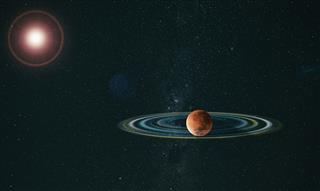
The jewel of the solar system has many fascinating facts hidden on its silent planes. Saturn is the only planet that has visible rings. If you are wondering how many rings it has, then read on to find out.
Saturn is named after the Roman god Saturn. In other mythologies Saturn is supposed to be equal to the Greek Kronos, the Babylonian Ninurta and the Hindu God Shani. The symbol for Saturn is god’s sickle ‘♄’. Saturn is the second largest planet in the solar system after Jupiter. The gas planets consisting of Saturn, Jupiter, Uranus and Neptune are together known as the Jovian. Even ‘Saturday’, a day of the week is named after Saturn.
Saturn is known for its elaborate ring system. Galileo, while observing Saturn in the year 1610, thought the rings were two moons of Saturn that were stuck on either side of Saturn. The rings were discovered by Christian Huygens in 1655, with the help of his more advanced telescope. These rings have distinct divisions and are made from icy particles orbiting the planet.
Saturn Rings
Saturn rings are made of small chunks of ice. These chunky rings orbit the Saturn individually. They reflect 80% of the light falling on them, proving that they are made of ice instead of rock. These rings are as large as a few dozen meters and some are less than a millimeter.
How Old are Saturn Rings?
It is thought that Saturn rings may be present from the beginning of the solar system. The solar system is around 4.6 billion years old. The rings may have been created when a 300 km ice moon was torn apart due to Saturn’s gravity. This torn moon formed a ring around the planet Saturn. Astronomers feel the Saturn rings are too clean to be formed so long ago. Thus, they could be only 100 million years old.
Disappearing Saturn Rings
This marvelous phenomenon occurs when the Saturn’s axis is tilted just like our home planet. The rings do not actually disappear, but are just hidden from our view. Saturn changes its position during its 30 year journey around the sun. Thus, we may see the full rings and sometimes the rings are seen on the edge and we feel they have disappeared.
Number of Rings of Saturn
There are over more than a dozen rings and gaps with the rings. The two densest parts of the rings are named as A and B rings. They are separated by the Cassini Division followed by the C ring. These 3 main rings are followed by smaller and dusty rings; the D ring, G ring and E ring. There is an F ring that is present just outside the A ring. The E ring is found to be the outermost ring. It is extremely wide and begins at the orbit of Mimas and ends around the orbit of Rhea. The G Ring is an extremely thin and faint ring. It present halfway between the beginning of the E Ring and the F Ring. It has inner edge approximately 15,000 km inside the orbit of Mimas.
Thus, by adding up the 3 main rings and the 5 dusty rings you get 8 rings. But, if we add up the Cassini Division we get 9 rings as the answer. And that’s not the only answer. There are other rings around Saturn, the Janus Ring, the Methone Ring Arc, the Anthe Ring Arc and the Pallene Ring. You also have the Roche Division. So, now we have the 12 rings plus 2 divisions.
The various rings have divisions and gaps within them. These gaps bring the count to more than 30. Few of these are the Encke Gap, the Huygens Gap, the Dawes Gap, etc. Thus, if you look at Saturn you will be able to see 3 rings. With a very powerful telescope you will be able to sight 8 rings. And with the special spacecraft like Cassini, you will be able to count and view 30 rings.
Saturn rings are so large that they won’t be able to fit the space between Earth and the Moon. They have a diameter of about 275,000 kilometers that is just a little less than the distance between Earth and Moon. The B ring has radial spokes of dust-sized material. These materials change their appearance every time they appear. They change and disappear frequently. The densest ring is the E ring, which is at the orbit of Enceladus. You can see light shining through the rings when Saturn passes in front of a star. Saturn rings are truly the jewels of the solar system.
Additional Facts
Saturn is the sixth planet from the sun that is present between Jupiter and Uranus. It has a mean distance of 1.43 billion kilometers from the sun and it is approximately 10 times the distance from Earth to the sun. The effective temperature on Saturn is -288 °F. Saturn has a density of 0.687 grams/cubic centimeter. That means it is less dense than water on Earth which is 1 gram/cubic centimeter. Thus, Saturn would actually float in a large pool of water!
This second largest planet can spin so hard on its axis that it flattens itself out. A year on Saturn is almost 29½ Earth years long. And a day is only 10½ hours long. Saturn is made of hydrogen and helium and heavier materials in its core. Thus, there is no surface on Saturn to stand on.





























